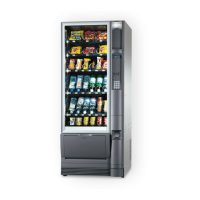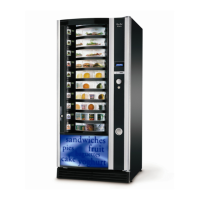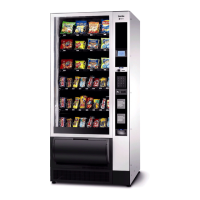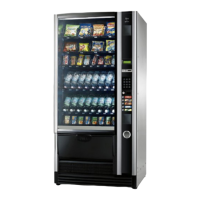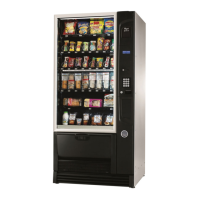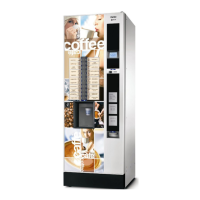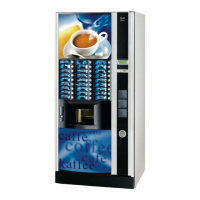Do you have a question about the Necta Snakky Max and is the answer not in the manual?
Declares machine compliance with European directives and harmonised standards, listing relevant directives and specifications.
Details how to identify the machine using its serial number and rating plate for technical information.
Covers safe usage practices, including biodegradable products and proper disposal methods.
Details voltage, frequency, absorbed power, and fuse protection for the machine.
Provides physical measurements including height, width, depth, and overall weight.
Outlines compressor refrigeration output and evaporator specifications.
Explains how to use and change the lock combination for machine access.
Details the main switch function for safe maintenance and cleaning operations.
Explains how to adjust spirals for different product sizes and dispensing needs.
Provides instructions for cleaning the vending machine to meet health and safety regulations.
Guides users on how to properly load products into the trays for dispensing.
Describes the checks and information displayed during the machine's start-up.
Instructions for carefully unpacking the machine and checking for any damage.
Details on how to install various payment systems, emphasizing installer responsibility.
Explains safe connection to the power supply, grounding, and cable specifications.
Describes the external controls, display, and keypad functions for user interaction.
Identifies key internal parts like the evaporator, CPU board, and cooling unit.
Provides steps for manually releasing the dispensing compartment if power is off.
Explains interaction via LCD display, keypad, and navigation keys.
Describes how the 5-button keypad is used for product selection.
Details the default operational mode and access to the filler menu.
Covers connecting a printer and displaying stored operational data.
Procedures for resetting various statistical counters.
Details on setting prices per selection and managing change tubes.
Details the photocell system for detecting product passage and error handling.
Outlines various tests like selections, motor tests, and autotests for diagnostics.
Covers reading, resetting failures, and checking motor error status.
Details programming for cash handling, selection pricing, and time bands.
Configuration options for various coin mechanisms and payment systems.
Settings for connecting machines in a bank and creating combined selections.
Controls for temperature, defrosting, and cold unit operation.
Settings for language, user messages, and display contrast.
Options for password protection and controlling filler menu visibility.
Storing machine codes, dates, and initialising system settings.
Configuration for data transfer, GSM alarms, and network identification.
Explains the functions of the CPU board and its indicator LEDs.
Details board configuration via dip-switches and software updates.
How to configure trays and use spacers for different product sizes.
Instructions for replacing spirals and removing/fitting trays.
Steps to change the number of trays from 7 to 5 or 6.
Guidance on changing spiral setup within trays for different selections.
Identifies fuses, switches, and connectors on the power supply unit.
Procedures for accessing the cooling unit for maintenance or inspection.
Declares machine compliance with European directives and harmonised standards, listing relevant directives and specifications.
Details how to identify the machine using its serial number and rating plate for technical information.
Covers safe usage practices, including biodegradable products and proper disposal methods.
Details voltage, frequency, absorbed power, and fuse protection for the machine.
Provides physical measurements including height, width, depth, and overall weight.
Outlines compressor refrigeration output and evaporator specifications.
Explains how to use and change the lock combination for machine access.
Details the main switch function for safe maintenance and cleaning operations.
Explains how to adjust spirals for different product sizes and dispensing needs.
Provides instructions for cleaning the vending machine to meet health and safety regulations.
Guides users on how to properly load products into the trays for dispensing.
Describes the checks and information displayed during the machine's start-up.
Instructions for carefully unpacking the machine and checking for any damage.
Details on how to install various payment systems, emphasizing installer responsibility.
Explains safe connection to the power supply, grounding, and cable specifications.
Describes the external controls, display, and keypad functions for user interaction.
Identifies key internal parts like the evaporator, CPU board, and cooling unit.
Provides steps for manually releasing the dispensing compartment if power is off.
Explains interaction via LCD display, keypad, and navigation keys.
Describes how the 5-button keypad is used for product selection.
Details the default operational mode and access to the filler menu.
Covers connecting a printer and displaying stored operational data.
Procedures for resetting various statistical counters.
Details on setting prices per selection and managing change tubes.
Details the photocell system for detecting product passage and error handling.
Outlines various tests like selections, motor tests, and autotests for diagnostics.
Covers reading, resetting failures, and checking motor error status.
Details programming for cash handling, selection pricing, and time bands.
Configuration options for various coin mechanisms and payment systems.
Settings for connecting machines in a bank and creating combined selections.
Controls for temperature, defrosting, and cold unit operation.
Settings for language, user messages, and display contrast.
Options for password protection and controlling filler menu visibility.
Storing machine codes, dates, and initialising system settings.
Configuration for data transfer, GSM alarms, and network identification.
Explains the functions of the CPU board and its indicator LEDs.
Details board configuration via dip-switches and software updates.
How to configure trays and use spacers for different product sizes.
Instructions for replacing spirals and removing/fitting trays.
Steps to change the number of trays from 7 to 5 or 6.
Guidance on changing spiral setup within trays for different selections.
Identifies fuses, switches, and connectors on the power supply unit.
Procedures for accessing the cooling unit for maintenance or inspection.
| Type | Snack Vending Machine |
|---|---|
| Model | Snakky Max |
| Manufacturer | Necta |
| Power Supply | 230V/50Hz |
| Number of Selections | 40 |
| Display | LCD |
| Payment Options | Cashless |
| Temperature Range | +5°C to +25°C |
